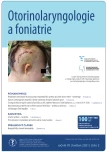The importance of screening questionnaires in detecting the severity of obstructive sleep apnea
Authors:
Solecká Š. 1,2; J. Betka 3; Matler K. 1; Tomášková H. 2
Authors‘ workplace:
Otorinolaryngologické oddělení, Nemocnice ve Frýdku-Místku, příspěvková organizace
1; Ústav epidemiologie a ochrany veřejného zdraví, LF Ostravské univerzity, Ostrava
2; Klinika otorinolaryngologie a chirurgie hlavy a krku 1. LF UK a FN v Motole, Praha
3
Published in:
Otorinolaryngol Foniatr, 70, 2021, No. 2, pp. 75-81.
Category:
Original Article
doi:
https://doi.org/10.48095/ccorl202175
Overview
Introduction: The aim of this study is to compare the importance of screening questionnaires and risk factors in detecting the severity of obstructive sleep apnea (OSA). Methods: The study included 47 patients with suspected OSA. The patients completed 5 screening questionnaires – the Epworth Sleepiness Scale (ESS), the STOP BANG questionnaire, the STOP questionnaire, the Berlin questionnaire (BQ) and the Pittsburgh Sleep Quality Index (PSQI). Subsequently, they were examined by the limited polygraphy. AHI (number of apneas/ hypopneas per 1 hour), t90 desaturation (percentage of sleep time spent in desaturations below 90%) and ODI (number of desaturations ≥ 3% within 1 hour) were compared with questionnaire scores and selected risk factors for OSA (BMI, male gender, hypertension, age, neck circumference, abdominal circumference and abdominal/ hip circumference ratio). Results: The achieved score of any of the monitored questionnaires does not correlate with the value of AHI. BQ, STOP and STOP BANG questionnaires have the relatively highest sensitivity for OSA detection, while the sensitivity of PSQI and ESS is low. The correlation of the ESS, STOP BANG and BQ scores with the t90 desaturation, as well as the ESS and STOP BANG scores with the ODI is statistically signifi cant. The relationship of any of the selected risk factors with the AHI value has not been demonstrated. Desaturation values of t90 and ODI correlated best with BMI, neck circumference and abdominal/ hip circumference ratio. Conclusion: None of the monitored questionnaires is suitable for determining the severity of OSA, it is always necessary to perform a polygraphic or polysomnographic examination of sleep. BQ and STOPBANG are relatively most suitable for OSA screening. They both have high sensitivity and, at the same time, their score correlates with the value of nocturnal hypoxemia. Parameters measuring nocturnal hypoxemia (t90 desaturation, ODI) correlate better with risk factors than AHI. The most important parameters associated with hypoxemia are BMI, neck circumference and abdominal/ hip circumference ratio and it is appropriate to include them in the screening for OSA.
Keywords:
obstructive sleep apnea – Berlin questionnaire – STOP-Bang questionnaire – STOP questionnaire – Epworth sleepiness scale – Pittsburgh Sleep Quality Index
Sources
1. Klozar J, Plzák J, Ondrová M et al. Doporučený postup u dospělých pacientů s poruchami dýchání ve spánku. Otorinolaryngol Foniatr 2016; 62(4): 243–246.
2. Peppard PE, Young T, Barnet JH et al. Increased prevalence of sleep-disordered breathing in adults. Am J Epidemiol 2013; 177(9): 1006–1014. Doi: 10.1093/ aje/ kws342.
3. Johns MW. A new method for measuring daytime sleepiness: the Epworth sleepiness scale. Sleep 1991; 14(6): 540–545. Doi: 10.1093/ sleep/ 14.6.540.
4. Chung F, Yegneswaran B, Liao P et al. STOP questionnaire: a tool to screen patients for obstructive sleep apnea. Anesthesiology 2008; 108(5): 812–821. Doi: 10.1097/ ALN.0b013e3 1816d83e4.
5. Netzer NC, Stoohs RA, Netzer CM et al. Using the Berlin Questionnaire to identify patients at risk for the sleep apnea syndrome. Ann Intern Med 1999; 131(7): 485–491. Doi: 10.7326/ 0003- 4819-131-7-199910050-00002.
6. Buysse DJ, Reynolds CF 3rd, Monk TH et al. The Pittsburgh Sleep Quality Index: a new instrument for psychiatric practice and research. Psychiatry Res 1989; 28(2): 193–213. Doi: 10.1016/ 0165-1781(89)90047-4.
7. Mediano O, Barcelo A, de la Pena M et al. Daytime sleepiness and polysomnographic variables in sleep apnoea patients. Eur Respir J 2007; 30(1): 110–113. Doi: 10.1183/ 09031936.00009506.
8. Chiu HY, Chen PY, Chuang LP et al. Diagnostic accuracy of the Berlin questionnaire, STOP- -BANG, STOP, and Epworth sleepiness scale in detecting obstructive sleep apnea: A bivariate meta-analysis. Sleep Med Rev 2017; 36: 57–70. Doi: 10.1016/ j.smrv.2016.10.004.,
9. Abrishami A, Khajehdehi A, Chung F. A systematic review of screening questionnaires for obstructive sleep apnea. Can J Anaesth 2010; 57(5): 423–438. Doi: 10.1007/ s12630-010- 9280-x.
10. Kezirian EJ, Harrison SL, Ancoli-Israel S et al. Behavioral correlates of sleep-disordered breathing in older men. Sleep 2009; 32(2): 253–261. Doi: 10.1093/ sleep/ 32.2.253.
11. Buysse DJ, Hall ML, Strollo PJ et al. Relationships between the Pittsburgh Sleep Quality Index (PSQI), Epworth Sleepiness Scale (ESS), and clinical/ polysomnographic measures in a community sample. J Clin Sleep Med 2008; 4(6): 563–571.
12. Carpenter JS, Andrykowski MA. Psychometric evaluation of the Pittsburgh Sleep Quality Index. J Psychosom Res 1998; 45(1): 5–13. Doi: 10.1016/ s0022-3999(97)00298-5.
13. Scarlata S, Pedone C, Curcio G et al. Pre-polysomnographic assessment using the Pittsburgh Sleep Quality Index questionnaire is not useful in identifying people at higher risk for obstructive sleep apnea. J Med Screen 2013; 20(4): 220–226. Doi: 10.1177/ 0969141313511591.
14. Lavie P, Herer P, Hoff stein V. Obstructive sleep apnoea syndrome as a risk factor for hypertension: population study. Br Med J 2000; 320(7233): 479–482. Doi: 10.1136/ bmj.320.7233.479.
15. Deng X, Gu W, Li Y et al. Age-group-specific associations between the severity of obstructive sleep apnea and relevant risk factors in male and female patients. PLoS One 2014; 9(9): e107380. Doi: 10.1371/ journal.pone.0107380.
Labels
Audiology Paediatric ENT ENT (Otorhinolaryngology)Article was published in
Otorhinolaryngology and Phoniatrics

2021 Issue 2
Most read in this issue
- Biological therapy of chronic rhinosinusitis
- Grisel’s syndrome – case report
- Surgical treatment of benign parotid gland tumors in the years 2014–2018 at the ENT department of Hospital České Budějovice, a.s.
- Neuromonitoring of the recurrent laryngeal nerve in thyroid gland surgery – results and experiences
